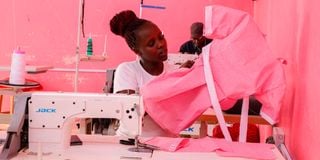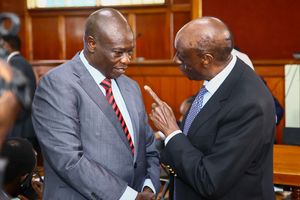The runaway brides of Narok: Three girls, three daring escapes, three reimagined lives

Sylvia Tarakwei in a workshop at House of Hope in Narok on September 26, 2024.
What you need to know:
- In Narok County, three young women like Maryann, Sylvia, and Cynthia are courageously defying deeply rooted traditions by escaping FGM and child marriage, often at great personal risk.
- These brave girls have transformed their lives through education and vocational training, evolving from potential child brides into self-reliant entrepreneurs who can support themselves and their families.
The rhythmic clack of a knitting machine fills the air as Maryann Naipanoi's nimble fingers guide vibrant wool through its metal teeth. Her brow furrows in concentration, eyes fixed on the emerging pattern of a sweater taking shape before her.
At just 22, Maryann's skilled hands tell a story of resilience, escape, and unexpected triumph.
Four years ago, those same hands were calloused from herding cattle under the relentless Narok sun, her future hanging by a thread as thin and fragile as the one she now expertly weaves.
"I overheard them planning," Maryann recalls, her voice barely above a whisper. "They were going to cut me, then marry me off. I was only 18."
The acrid smell of wood smoke from nearby cooking fires mingles with the warm scent of wool as Maryann continues her work. Each stitch is a quiet rebellion against the fate that once seemed inevitable.
Maryann's tale of narrow escape from female genital mutilation (FGM) and child marriage is not unique in Kenya's Narok County. It's a story echoed by countless girls, three of whom – Maryann, Sylvia Tarakwai, and Cynthia Muteno – now stand as beacons of hope for a new generation.
Sylvia's journey began on a chilly morning in 2019 when, at just 13 years old, she was subjected to FGM.
"I was in Class Seven," she recalls, her eyes distant.
"One year later, after my primary school exams, I saw men bringing cows to my father. I knew what it meant – I was to be married."

Maryann Naipanoi, 22, at work at the House of Hope in Narok County on September 26, 2024.
The memory of that day is etched in Sylvia's mind: the lowing of the cattle, the hushed conversations, and the growing knot of dread in her stomach.
"I felt like a prized goat being sold at the market," she says, her voice tinged with lingering hurt.
For three harrowing months, Sylvia lived as a child bride before a dramatic night-time rescue.
"Police came and arrested my husband and his parents," she says. "I was taken to a rescue centre near Narok town. It felt like waking from a nightmare."
The rescue centre became a sanctuary, its walls adorned with colourful posters proclaiming girls' rights and education. Here, amidst the chatter of other rescued girls and the gentle guidance of mentors, Sylvia began to reimagine her future.
At the centre, she discovered a talent for tailoring. Today, at 18, she earns a steady income making school uniforms.
"My starting salary was Sh15,000," she says, pride evident in her voice.
"It helps me care for my siblings, my mother, and my young child. I was suffering, but now I am self-reliant."
The whir of Sylvia's sewing machine has become a melody of independence, each completed uniform a testament to her resilience.
"I dream of owning my own school uniform production company," she says, her eyes shining with determination. "I know it will come true."
Cynthia Muteno's story took a different turn. At 14, she outran the cut, quite literally.
"My father told me I was to be cut and married off," she recounts.
"I ran to my elder sister, terrified. She hid me for two months before I found safety at the rescue centre."
Cynthia remembers those two months of hiding: the constant fear of discovery, sleeping on the floor of her sister's small home, and the gnawing uncertainty about her future.
"Every unfamiliar sound made my heart race," she recalls. "I thought they had found me."
Now 22, Cynthia is on the cusp of graduating with a diploma in Supply Chain and Procurement Management. Her eyes sparkle as she speaks of the future.
"I hope to get married, start a family, and have a career – on my own terms."

Cynthia Muteno, 21, in Narok County on September 26, 2024.
These three young women represent a growing movement in Narok and across Kenya – girls who are saying "no" to harmful traditional practices and forging their own paths. Their stories are part of a larger narrative of change, one that's slowly but surely altering the landscape of women's rights in the region.
Patrick Ngige, the founder of House of Hope Rescue Centre, the shelter that has become a haven for girls like Maryann, Sylvia, and Cynthia, has witnessed this transformation first-hand. A former teacher, Ngige was moved to action 27 years ago when he noticed a troubling pattern among his female students.
"Girls who were in danger of being subjected to FGM and child marriage would come to me and beg to be rescued," Ngige recalls, his voice heavy with the weight of countless stories. "I would take them to my home, but the number kept growing, making it impossible. That's how the rescue centre came to be."
What started as a small safe house with a capacity of 12 has grown into a lifeline for hundreds of girls.
"We've hosted a total of 1,300 girls," he says with a mix of pride and sadness. "150 of them have been supported through secondary school and college education. But the need is still great."
Recent data from the 2022 Kenya Demographic Health Survey offers a glimmer of hope: FGM prevalence in Narok has decreased from 74 per cent in 2014 to 51 per cent in 2022. While the numbers remain alarming, they point to progress.
Anders Thomsen, UNFPA Country Representative, emphasises the complexity of the challenge.
"Deeply rooted socio-cultural norms require sustained engagement with communities," he explains.
"We're supporting local and grassroots organisations, implementing long-term, community-led interventions to eliminate these practices."
The fight against FGM and child marriage in Narok is multi-faceted, involving law enforcement, community education, and crucially, safe havens for girls at risk. These rescue centres provide not just physical safety but opportunities for education and skill development.
William Mbanyamlenge, a project officer at the Centre for Rights, Education, and Empowerment (Creaw), has witnessed the impact first-hand.
"Over the past year, we've seen tremendous strides," he notes. "More women and girls in Narok are becoming empowered and informed about their rights."
The change is palpable in the communities surrounding Narok. Where once the sound of celebration often heralded another child marriage, now it's increasingly likely to mark a girl's educational achievement or the launch of a small business.
Yet challenges remain. Weak law enforcement and limited resources continue to hamper efforts. The road to complete eradication of FGM and child marriage is long, but stories like those of Maryann, Sylvia, and Cynthia light the way.
As the sun sets over Narok, painting the sky in hues of orange and purple, Maryann puts the finishing touches on her sweater. Her fingers, once destined for a life of early motherhood and limited choices, now create beauty and independence with every stitch. She looks up, a slow smile spreading across her face.
"I have become an expert in knitting, and I can now earn a living," she says. "It has helped me to get a foundation in life."
In the gentle whir of Maryann's knitting machine, in Sylvia's determined work at her sewing table, in Cynthia's academic pursuits, we hear the sound of change. It's the sound of girls reclaiming their futures, one brave decision at a time.
The aroma of cooking fires once again wafts through the air, but for these young women, it no longer signals the end of dreams. Instead, it's the scent of homes they will build on their own terms, of futures bright with possibility.





